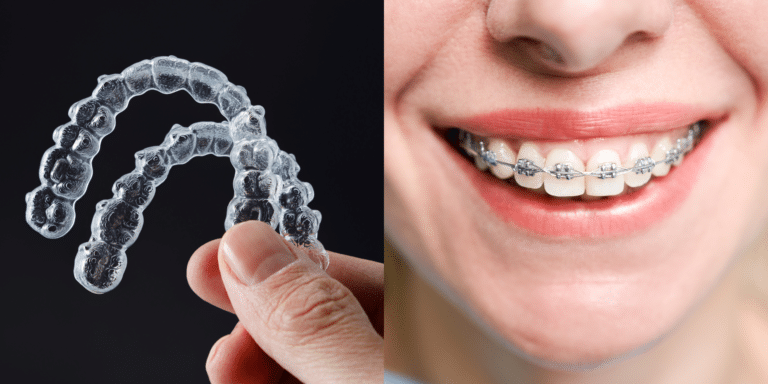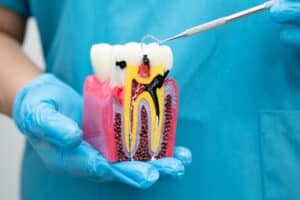When it comes to straightening your teeth, your decision between Invisalign and traditional braces can be challenging.
Both options have their unique advantages and drawbacks.
This guide will help you understand the key differences between Invisalign and braces, enabling you to make an informed decision based on your orthodontic needs.
Understanding Invisalign
What is Invisalign?
Invisalign is a modern orthodontic treatment that uses a series of clear, removable aligners to gradually move your teeth into their desired position. These aligners are custom-made for each patient using 3D computer imaging technology, ensuring a precise fit and effective treatment.
How Does Invisalign Work?
Invisalign aligners are worn for 20-22 hours a day and are replaced with a new set every one to two weeks. Each set of aligners is slightly different, applying gentle pressure to your teeth to move them incrementally. Regular check-ups with your dentist or orthodontist ensure that your treatment progresses as planned.
Benefits of Invisalign
- Aesthetic Appeal: One of the most significant advantages of Invisalign is that the aligners are virtually invisible, making them an excellent choice for those who are self-conscious about wearing braces.
- Comfort: Invisalign aligners are made of smooth plastic, reducing the risk of irritation to your gums and cheeks.
- Convenience: The aligners are removable, allowing you to eat, drink, brush, and floss without any restrictions.
Understanding Braces
Types of Braces
Traditional braces consist of metal brackets and wires that are attached to your teeth. However, there are several types of braces available today, including ceramic braces, which are less noticeable, and lingual braces, which are attached to the back of your teeth.
How Do Braces Work?
Braces work by applying continuous pressure to your teeth, gradually moving them into the desired position. The brackets are bonded to your teeth and connected by wires, which your orthodontist adjusts periodically to ensure steady progress.
Benefits of Braces
- Effectiveness: Braces are highly effective for treating a wide range of orthodontic issues, including complex cases that may not be suitable for Invisalign.
- No Compliance Issues: Unlike Invisalign, braces are fixed in place, eliminating the risk of patients not wearing their aligners as prescribed.
- Versatility: Braces can be used to correct more severe alignment problems and bite issues.
Comparing Invisalign and Braces
Effectiveness
While both Invisalign and braces are effective at straightening teeth, the complexity of your case may determine the best option. Braces are often recommended for more severe orthodontic issues, whereas Invisalign is suitable for mild to moderate cases.
Cost Comparison
The cost of Invisalign and braces can vary depending on the complexity of your treatment and your location. In general, the prices are comparable, but it’s essential to check with your dentist or orthodontist for a detailed quote and to discuss any available payment plans or insurance coverage.
Aesthetic Considerations
Invisalign aligners are nearly invisible, making them a popular choice for adults and teens who want to maintain a natural appearance during treatment. Braces, on the other hand, are more noticeable, although ceramic braces offer a less conspicuous alternative to traditional metal braces.
Comfort and Convenience
Invisalign aligners are designed for comfort and can be removed for eating, drinking, and oral hygiene. However, this convenience requires discipline, as the aligners must be worn for the recommended 20-22 hours daily to be effective. Braces are fixed in place, which means no need to remember to wear them, but they can cause some discomfort and require careful cleaning to maintain oral hygiene.
Braces vs Invisalign: Making Your Decision
Choosing between Invisalign and braces ultimately depends on your specific orthodontic needs, lifestyle, and personal preferences. Consulting with an experienced dentist and orthodontist is crucial in making an educated and informed decision. They can evaluate your dental health, discuss your treatment goals, and recommend the best option for achieving a beautiful, healthy smile.
In conclusion, both Invisalign and braces have their pros and cons. Invisalign offers a discreet and comfortable option for those with mild to moderate orthodontic issues, while braces provide a reliable solution for more complex cases. Consider your priorities and consult with a professional to find the best fit for your smile journey.




